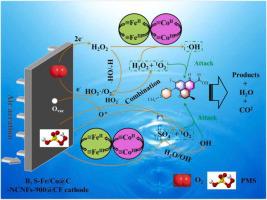Journal of Hazardous Materials ( IF 12.2 ) Pub Date : 2022-09-23 , DOI: 10.1016/j.jhazmat.2022.130016 Xian Li 1 , Yongyou Hu 2 , Changyong Zhang 3 , Chun Xiao 1 , Jianhua Cheng 4 , Yuancai Chen 4

|
To address the difficulty of precisely regulating the two-electron oxygen reduction reaction (2e-ORR) and investigate the synergistic effect of hydrogen peroxide (H2O2) and peroxymonosulfate (PMS), a heterogeneous electro-catalyst was synthesized via carbonation of boron (B) and sulfur (S) co-doping electrospun nanofibers containing iron and cobalt (B, S-Fe/Co@C-NCNFs-900), and used to degrade levofloxacin (Levo) in the electro-activating PMS with self-made cathode material (E-cathode-PMS) system. The morphological, structural, and electrochemical characteristics have been investigated. The results showed that B and S co-doping could remarkably enhance electron transfer and manage two-electron oxygen reduction, which was more favorable for H2O2 generation. Levo degradation efficiency could reach 99.63% with a reaction rate of 0.3056 min−1 in 20 min under the appropriate conditions (pH = 4, current = 20 mA, and [PMS] = 8.0 mM). The steady-state concentration of singlet oxygen (1O2) was calculated to be 669.17 × 10−14 M, which was 15.42, 29.74, and 45.00 times respectively than that of HO2·/O2·- (43.40 × 10−14 M), ·OH (22.25 × 10−14 M) and SO4-·(14.87 × 10−14 M), signifying that 1O2 was the predominant reactive oxygen species (ROS) involved in Levo removal. The high TOC removal (74.19%), low energy consumption (0.14 kWh m−3 order−1), few intermediates toxicity, and excellent Levo degradation efficiency for complex wastewater with various anions and matrixes showed the prospective practical applications of the E-cathode-PMS system. Overall, this study provides a useful strategy to regulate and control the 2e-ORR pathway.
中文翻译:

硼硫共掺杂大孔碳纳米纤维阴极电活化过氧单硫酸盐高效降解左氧氟沙星
为了解决精确调控双电子氧还原反应(2e-ORR)的难题,研究过氧化氢(H 2 O 2)和过氧单硫酸盐(PMS)的协同效应,通过硼的碳化合成了一种非均相电催化剂。 (B) 和硫 (S) 共掺杂含有铁和钴 (B, S-Fe/Co@C-NCNFs-900) 的电纺纳米纤维,用于在具有自催化作用的电激活 PMS 中降解左氧氟沙星 (Levo)制成阴极材料(E-cathode-PMS)系统。对其形态、结构和电化学特性进行了研究。结果表明,B和S共掺杂可以显着增强电子转移和控制双电子氧还原,这对H 2 O 2更有利。一代。在适当的条件下(pH = 4,电流 = 20 mA,[PMS] = 8.0 mM),Levo 降解效率可达到 99.63%,20 分钟内的反应速率为 0.3056 min -1 。计算得到单线态氧( 1 O 2 )的稳态浓度为669.17 × 10 -14 M,分别是HO 2 ·/O 2 · - (43.40 × 10 -的15.42、29.74和45.00倍) 14 M)、·OH (22.25 × 10 -14 M) 和 SO 4 - ·(14.87 × 10 -14 M),表示1 O 2是参与左旋去除的主要活性氧(ROS)。高 TOC 去除率(74.19%)、低能耗(0.14 kWh m -3 order -1)、极少的中间体毒性以及对具有各种阴离子和基质的复杂废水的优异的 Levo 降解效率显示了 E 阴极的前瞻性实际应用-PMS系统。总体而言,本研究提供了一种有用的策略来调节和控制 2e-ORR 通路。











































 京公网安备 11010802027423号
京公网安备 11010802027423号